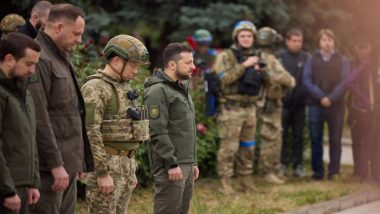Izium, September 14: Ukrainian President Volodymyr Zelenskyy visited the recently retaken city of Izium on Wednesday, greeting soldiers and thanking them for their efforts in retaking the area, as the Ukrainian flag was raised in front of the burned-out city hall building.
Russian forces left the war-scarred city last week as Ukraine pressed forward in a sweeping counteroffensive that has reclaimed vast swaths of territory in the country's northeastern Kharkiv region in a matter of days. Russia-Ukraine War: What is Vladimir Putin's Next Move in the Face of Ukrainian Battlefield Victories?
Volodymyr Zelenskyy Visits Izium
Volodymyr Zelensky came to the liberated Izium, Kharkiv region (North-East of Ukraine), where the flag of Ukraine 🇺🇦 was officially raised today.
Photo: 25th Separate Sicheslav Airborne Brigade. pic.twitter.com/mUQaBDAFkg
— Toronto Television / Телебачення Торонто (@tvtoront) September 14, 2022
Much of Izium has been devastated. Apartment buildings are blackened by fire and pockmarked by artillery strikes. The entire centre of one residential building had collapsed, a gaping hole and piles of rubble where homes used to be.
“The view is very shocking but it is not shocking for me," Zelenskyy said in brief comments to the press, "because we began to see the same pictures from Bucha, from the first de-occupied territories … so the same destroyed buildings, killed people”.
Bucha is a neighbourhood near Kyiv where the bodies of civilians, many of them bearing signs of torture, were found dumped in the streets, in mass graves and in yards after Russian forces withdrew hastily in March. On the northern outskirts of Izium, the remains of Russian tanks and vehicles lie shattered along the road.
“Our soldiers are here. That's a very important thing. It supports people,” Zelenskyy said. “I see how people meet them, in what a sensitive moment. It means that with our army, the life comes back.”
Ukrainian troops have recently carried out a dramatic counteroffensive that has allowed them to recapture large swaths of territory around Kharkiv and inflict a stunning blow on Moscow's military prestige. Following those gains, a new front line has started to emerge in the war, a Washington-based think tank said on Wednesday.
The Institute for the Study of War said the Oskil River appeared to be becoming the new front line in the area after Kyiv's significant gains in recent days. The Oskil River flows south and largely represents the eastern edge of Ukraine's Kharkiv region.
“Ukrainian forces are continuing localised ground assaults to threaten Russian positions behind the Oskil River,” the institute said. “Russian troops are unlikely to be strong enough to prevent further Ukrainian advances along the entire Oskil River because they do not appear to be receiving reinforcements, and Ukrainian troops will likely be able to exploit this weakness to resume the counter-offensive across the Oskil if they choose, ”it added.
The counter-offensive has also left more weapons in Ukrainian hands. Russian forces likely left behind dozens of tanks, armoured personnel carriers and other heavy weaponry as they fled Ukraine's advance in the east of the country, a Ukrainian think tank said on Wednesday.
The Centre for Defence Strategies said one single Russian unit that was around Izium left behind 39 T-80 tanks and 35 infantry fighting vehicles, known by the acronym BMP. Another unit left behind 47 tanks and 27 armoured vehicles.
The centre said Russian forces tried to destroy some of the abandoned vehicles through artillery strikes as they fell back. Typically, armed forces destroy equipment left behind so their opponent can't use it. However, the chaos of the Russian withdrawal apparently saw them leave untouched ammunition and weapons behind.
In other areas, Russia has continued its attacks over the past day, causing the death toll to keep rising in the war that has now dragged on for more than seven months. Russian shelling of seven Ukrainian regions over the past 24 hours killed at least seven civilians and wounded 22 more, Ukraine's presidential office reported on Wednesday morning.
Two people were killed and three injured after Russia attacked Mykolaiv with S-300 missiles overnight, said regional Gov. Vitaliy Kim. An educational institution, infrastructure objects and residential buildings were damaged. Settlements near the frontline in Mykolaiv region remain under constant fire.
The Nikopol area, which is across the Dnieper River from the Zaporizhzhia nuclear power plant, was shelled three times during the night, but no injuries were immediately reported, said regional Gov. Valentyn Reznichenko.
Nikopol city itself was shelled two times and left almost 3,000 families without electricity. Reznichenko said the electricity has been partially restored. In the Kharkiv region, where Ukrainian forces have retaken more than 300 cities and villages, the process of demining is underway; three people have been injured over the past 24 hours.
In the neighbouring Luhansk region, where some of the Russian troops retreated from the Kharkiv region, mobile internet has been shut down, according to the region's governor Serhiy Haidai, and intense shelling of Ukrainian forces continues.
The fighting continued in the Donetsk region as well. Avdiivka, Bakhmut and Kramatorsk have come under a barrage of shelling, which killed five civilians and wounded 16 more. “Every night in Donbas is restless. The civilians should leave the region. It's a matter of life and death,” Donetsk governor Pavlo Kyrylenko said.













 Quickly
Quickly





















